#phonologies
Text
Studying linguistics is actually so wonderful because when you explain youth slang to older professors, instead of complaining about how "your generation can't speak right/ you're butchering the language" they light up and go “really? That’s so wonderful! What an innovative construction! Isn't language wonderful?"
#linguistics#gen z slang#english#as people in the reblog pointed out!#most gen z slang comes from (or was appropriated from) aave#honestly I was just excited to talk about how people in my field actually get excited about non standard uses of English#instead of ridiculing speakers#and I tagged incorrectly and didn’t point out the very real issues of language and power and appropriation inherent in modern slang#in that much of it was appropriated#and even that which experiences language change in the wider culture still originated in aave#aave is just as linguistically valid as any other English dialect because it is a proper language#and the grammar is incredible!!!#habitual be is fantastic and an excellent example of how a richer case system or a certain case can render an adverb unnecessary#and the phonology is just beautiful#anyway I’m very sorry#I fucked up
21K notes
·
View notes
Photo
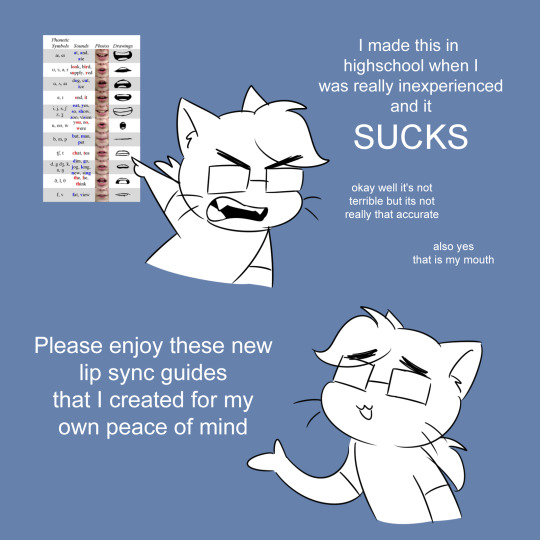
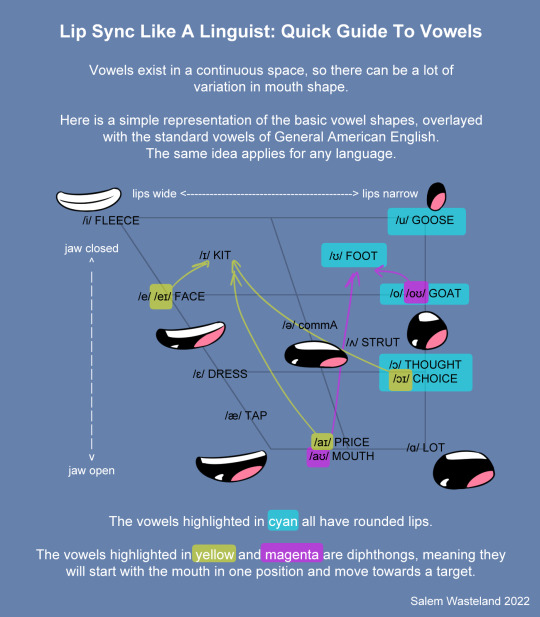
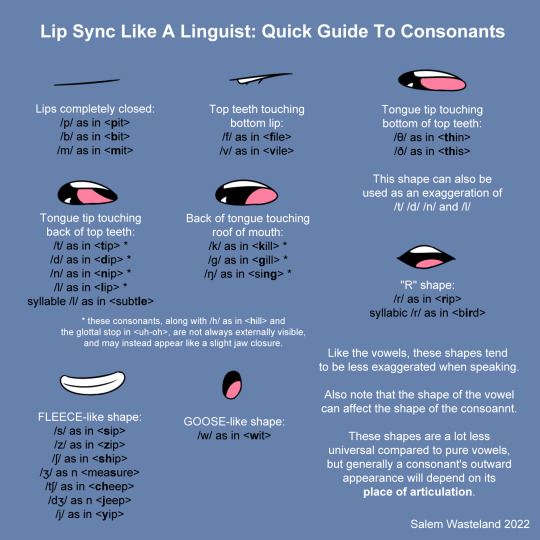
That ol’ chart of mine makes the rounds online periodically and it drives me crazy because it’s frankly not very good. So, I finally got around to remaking it.
I doubt this will get anywhere near as popular, but I wanted to make it.
Good reference for animation, comics, and for visualizing phonetics!
#animation#animation reference#art reference#lip sync#linguistics#phonetics#phonology#artists on tumblr#Salem's clever art tag#ref#reference#500#1k#5k#10k#25k
32K notes
·
View notes
Text
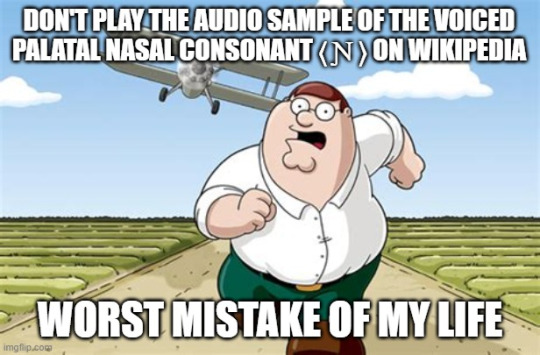
870 notes
·
View notes
Text
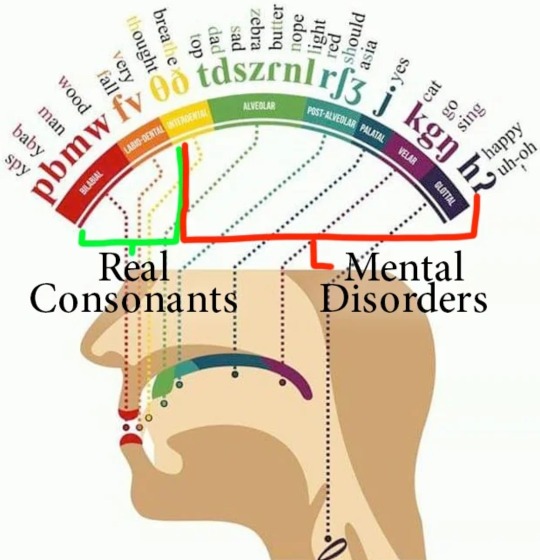
466 notes
·
View notes
Text

Source
2K notes
·
View notes
Text
I packed myself lunch for school today and I feel like such a six year old. Like omg yay I have my pb&j and my goldfish and my applesauce, I can't wait to go to class and learn about word sounds!
#that is the exact meal i packed#and im going to my phonology class. which is about word sounds#what is the difference between a grad student in linguistics and a first grader in a phonics class
84 notes
·
View notes
Text

glad to see the supercops in traning still learn about integrals, also the implication that these pro hereos also happen to be specialists with degrees in maths, english etc. is very very funny
#like that guy guy teaches english does he has a degree??#did he go to grad school to learn about shakespeare and phonology???#lb#bnha
78 notes
·
View notes
Text
How many different sounds -- reasonably distinguishable by human speakers and listener -- can a language have?
Looking at the table of the International Phonetic Alphabet, consonants are mainly distinguished by place and manner of articulation, which is to say the part of the mouth where the airflow is restricted to produce sound and how that restriction occurs.

The most restrictive consonants are called stops or plosives, which stop the airflow altogether and release it with a burst. The IPA table divides them into seven places of articulation: bilabial (p & b), coronal (t & d), retroflex (ʈ & ɖ, like t & d, but with your tongue curling backward in the mouth, common in Indian languages), palatal (c & ɟ, roughly like ky and gy), velar (k & g), uvular (q & ɢ, similar to k & g but pronounced further back in the mouth), and glottal (ʔ, the Bri'ish glo'al stop) (there is also an epiglottal stop ʡ which I really don't understand). Sometimes you also see labiodental stops (p̪, b̪) pronounced by touching lower lip and upper teeth, like the first sound in the German Pferd. The coronal t & d can be divided in dental, alveolar, and postalveolar, depending on where exactly the tip of your tongue touches your teeth, but distinguishing those is not common. (Though Dahalo distinguishes laminal and apical t & d, so produced with the blade vs. the tip of your tongue). Oh, and there's the labiovelar stops (k͡p, ɡ͡b) of African languages such as Igbo and Yoruba, which actually combines two places into one; and the linguolabial stops made by touching your tongue against your upper lip (t̼, d̼).
The stops in each of these places, except for the glottal, can also be articulated in different ways. The "basic" way is called voiceless (p t k). Then there is voiced articulation, in which your vocal chords vibrate to make the sound slightly more sonorous (b d g). Then they can be aspirated (pʰ tʰ kʰ, compare "t" in "top" vs. "stop": the first is released with a slight puff of air). They can also be both voiced and aspirated at the same time (bʱ dʱ gʱ, like in the original pronunciation of Buddha). Then there are ejectives (pʼ tʼ kʼ, like in Maya), when air is ejected from the mouth without passing through the throat at all, and implosives (ɓ ɗ ɠ, like in Vietnamese), where air goes the other way creating a "gulping" sound. There's such a thing as "nasal" and "lateral release" of stops, but from what I find they are not treated as distinct sounds from the standard form.
So using only stops gives us 10 places (bilabial, labiodental, linguolabial, laminal dental, apical dental, retroflex, palatal, velar, uvular, labiovelar) x 6 (voiceless, voiced, aspirated, voiced + aspirated, ejective, implosive) + 2 (glottal & epiglottal stops) = 62 distinct consonantal sounds. Good start.
The second-most restrictive manner of articulation is that of nasals, which close the mouth completely and redirect air through the nasal passage. The places of articulation are largely the same: bilabial (m), labiodental (ɱ, the "m" in "amphor"), linguolabial (n̼), coronal (n), retroflex (ɳ, like n but curling the tongue backward), palatal (ɲ, like "ni" in "onion" or Spanish ñ), velar (ŋ, like "ng" in "sing"), uvular (ɴ, the "n" in Japanese san), and the co-articulated labial-velar ŋ͡m (like m and ng at the same time). They can be both voiced and voiceless, even though the latter are rare. That makes for 10x2 = 20 nasal consonants.
Then come fricatives, which make hissing or buzzing sounds. Again similar places: bilabial (ɸ β, pronounced with lips almost touching, e.g. the first sound of Japanese Fuji), labiodental (f v), dental (θ ð, the "th" of "thigh" and "thy") linguolabial (θ̼ ð̼, see earlier), alveolar (s z), postalveolar (ʃ ʒ, like the central sounds of "fission" and "vision"), palato-alveolar (ɕ ʑ, like ʃ ʒ but with the tongue pushing forward), retroflex (ʂ ʐ, like ʃ ʒ but with the tongue curling backward), palatal (ç ʝ, the first like the "h" in "hue"), velar (x ɣ, the first like the "ch" in Bach), uvular (χ ʁ, like the previous but further back in the throat), epiglottal (ħ ʕ, don't ask), and glottal (h ɦ). Each of these can, again, be voiceless, voiced, or (except the last two) ejective. There is also a mysterious "palatal-velar" ɧ that seems to exist only in Swedish. I'm counting 11x3 + 2x2 + 1 = 38 fricative sounds.
Actually, there is a second row of lateral fricatives, in which air passses by the sides of the tongue. The most common is coronal (ɬ ɮ, like "ll" in Welsh), but there's also retroflex (ꞎ), palatal (ʎ̝), and velar (ʟ̝). All voiced or voiceless, so 8 more fricatives for a total of 46.
Approximants are yet looser. We got labiodental ʋ (the Hindi pronunciation of "v", kinda halfway between English v and w), coronal ɹ (a common English pronunciation of "r"), retroflex ɻ, palatal j ("y" in "year"), velar ɰ (an extremely soft sound, sometimes "g" between vowels in Spanish), and glottal ʔ̞, which I'm not counting because I think it's the same as a vowel modification we'll get to later. Oh, and then labiovelars (voiced w as in "wealth" and voiceless ʍ as in "whale") and labial-palatal ɥ (as "u" in French nuit). I think they could all be voiced and voiceless, so that's 7x2 = 14 approximants.
But approximants can be lateral too, with what you could call the "L series": coronal l (and its velarized counterpart ɫ as in "lull"), retroflex , ɭ, palatal ʎ (as "gl" in Italian), velar ʟ (as "l" in "alga"), and uvular ʟ̠. So thats 5x2 = 10 more to make 24.
Then taps or flaps. I'm not familiar with these, except that the coronal flap ɾ is how Spanish -r- and American English -tt- may sound between vowels. Then there's bilabial ⱱ̟, labiodental ⱱ, linguolabial ɾ̼, retroflex ɽ, uvular ɢ̆, and epiglottal ʡ̆. Adding the voiceless and lateral (and both) versions recorded in the chart, I get to 15 taps.
Finally there's trills. We get bilabial ʙ (a kind of raspberry sound), coronal r (the "rolled r"), retroflex ɽr (?), uvular ʀ (French "r"), and epiglottal ʜ & ʢ (which are sometimes among fricatives). Add unvoiced for all, and we get 5x2 = 10 trills.
No, wait. There's affricates too, which are really stops + fricatives (including lateral) of the same place of articulation. Each affricate can also be voiced vs. voiceless (except the glottal) and aspirated vs. not (except the epiglottal), so I believe that makes 15x4 + 2 + 1 = 63 affricates.
No, wait. There's still the clicks. They may be used only in languages from Southern Africa, but that's no excuse not to count them. I don't understand them perfectly, but the basic types seem to be bilabial ʘ (basically lip-smacking), dental ǀ (tsk), alveolar ǃ (like doing a clopping sound with your tongue), palatal ǂ, retroflex ‼ (don't ask me about these), and lateral ǁ (a clicking sound with the side of the tongue). Each of them can be voiceless or voiced, aspirated or not, nasalized or glottalized or have 6 types of pulmonic countour or 5 types of ejective contour, plus a preglottalized nasal type and an egressive only for the labial click (please don't ask me). I believe that makes for... 6 x ((4x3) + 6 + 5 + 1) + 1 = 145 potential click sounds, and some Khoisan languages go pretty close to using them all.
That's not quite all -- I haven't counted nasalization or glottalization of most types of consonants, for example, but by my count we have put together 62 stops + 20 nasals + 46 fricatives + 24 approximants + 15 taps + 10 trills + 63 affricates + 145 clicks = 385 distinct consonants sounds.
To be continued with the vowels.
90 notes
·
View notes
Text
No grilling intended, but common mistakes in viral language-related (English-focused) posts:
"English is a stupid, weird, and nonsensical language 'worse' than other languages because.... [says something cross-linguistically common]"
"This phenomenon in English deplorably arises from ignorant colonists because... [mentions a common paradigm for loanword spread that applies to multiple forms of linguistic contact and in no way is unique to colonialism nor English]"
"How hard is it for people to say [insert loanword that, like all loanwords, in any language, broadly adheres to the phonetic and phonological constraints of the adopted tongue]"
#blabbing Haddock#non-dragons#I'm not even putting tags on this one#ain't gonna make the mistake I did four years ago#'adheres to the phonetic and phonological constraints' broadly#as in: of course there's nuance to this
117 notes
·
View notes
Text
otoh as someone from an apple-branded country I'm obviously sensitive to pronunciation-associations otoh I've arrived at the point of worrying that these prescriptions are at best misguided corrections of L1 phonotactics and at worst vaguely classist invocations that are irrelevant to the hegemonies at hand. I am confident the average CIA fed with a poli sci education and a few arabic and/or farsi classes under their belt is saying it "right" already and I am not super concerned with "correcting" those who don't know this but know enough to be anti various imperialisms...
#text#i say this as someone who is very annoyed when ppl cant be bothered to acquire the rudiments of the phonology of a language#when they are gping to be using words/names from it a lot#but like i get it
34 notes
·
View notes
Text
Sound Change of the Day - 2024 April 20
/x/ becomes /w/ between /a/ and /o/.
(Proto-Eastern Muskogean to Creek)
#conlang#conlanging#phonology#conlang phonology#sound change#phonological change#sound shift#phonological shift
39 notes
·
View notes
Text
Me when creating a conlang: I love you sandhi, I love you vowel harmony, I love you consonant synharmony, I love you aspirated stops, I love you uvular consonants, I love you ejectives, I love you large consonant clusters, I love you open syllable structure, I love you strict consonants cluster parameters, I love you three vowel system, I love you lateral fricative, I love you syllabic consonants, I love you epenthetic vowels, I love you....
#conlang#constructed language#conlanging#phonology#worldbuilding#languages#linguistics#They are all my faves#Creating a mixed language so I can have 2 phonologies in one mwaahahahahahahahaha
76 notes
·
View notes
Note
I made an Auditory Processing Disorder flag based on the awareness color (lime green) and how it personally feels for me :)

Thanks!
#submission#y8#sourtabby#answered#mad pride#flags#auditory processing disorder#APD#hearing loss#King-Kopetzky syndrome#ADN#capd#neurodevelopmental disorder#neurological disorders#audiological#audiology#dyslexia#dyslexic#dislexia#psychoacoustics#learning disabilities#phonology#communication disorders#flag
42 notes
·
View notes
Text
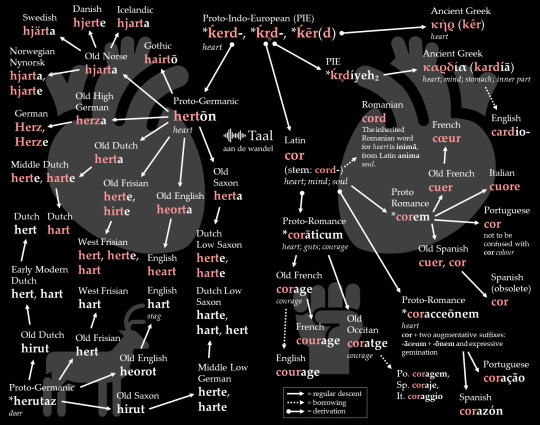
Heart is etymologically related to the prefix cardio-, courage and Spanish corazón. Because of early Germanic sound changes, the sounds that became c and d in Latin, became h and t in the Germanic languages:
cord- vs. heart
decem vs. ten
cornū vs. horn
See the graphic for more.
#linguistics#historical linguistics#language#etymology#english#latin#french#dutch#german#phonology#ancient greek#old french#spanish#old spanish#portuguese#romanian#italian#lingblr#old dutch#middle dutch#old saxon#low saxon#old frisian#west frisian#old norse#swedish#norwegian#danish#icelandic
201 notes
·
View notes
Text
178 notes
·
View notes
Text
I have officially finished the coursework for my master's degree!!!!!
#i submitted my last final paper!!!!!#i am so relieved to be done oh my god im so tired of phonological theory
28 notes
·
View notes